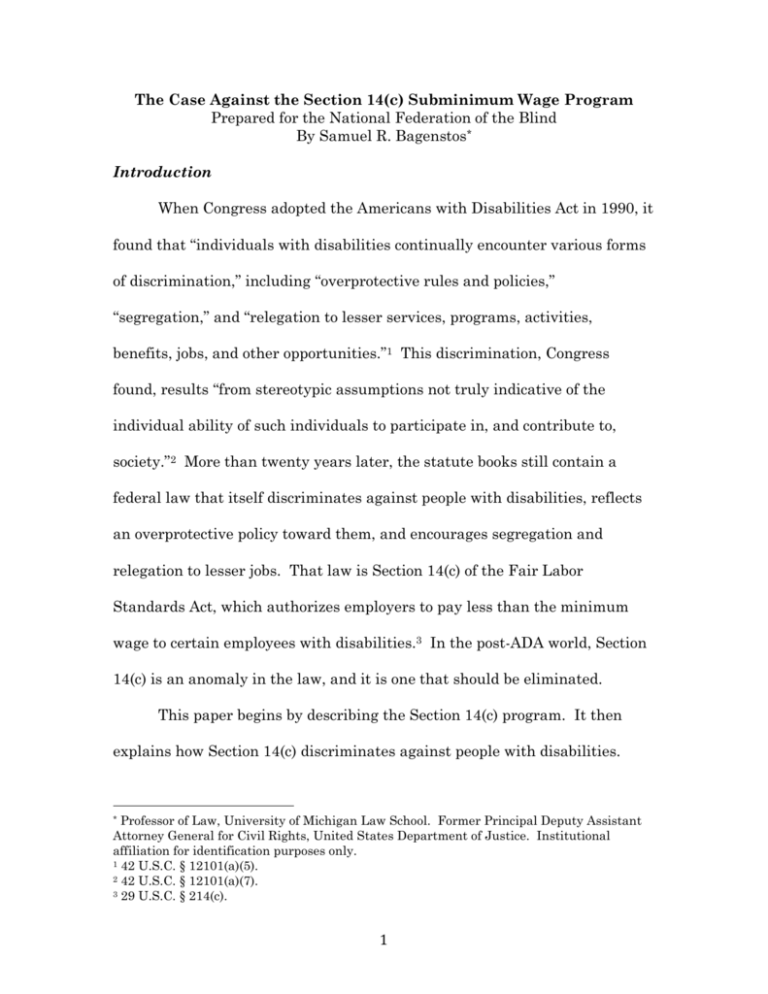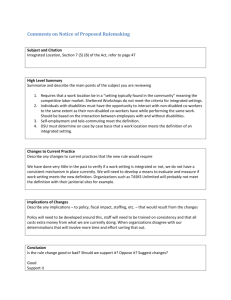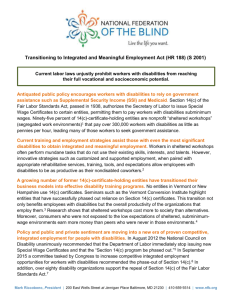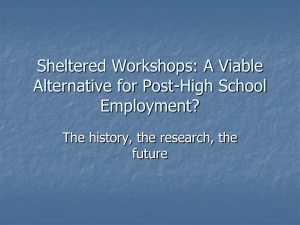The Case Against the Section 14(c) Subminimum Wage Program
advertisement

The Case Against the Section 14(c) Subminimum Wage Program Prepared for the National Federation of the Blind By Samuel R. Bagenstos* Introduction When Congress adopted the Americans with Disabilities Act in 1990, it found that “individuals with disabilities continually encounter various forms of discrimination,” including “overprotective rules and policies,” “segregation,” and “relegation to lesser services, programs, activities, benefits, jobs, and other opportunities.”1 This discrimination, Congress found, results “from stereotypic assumptions not truly indicative of the individual ability of such individuals to participate in, and contribute to, society.”2 More than twenty years later, the statute books still contain a federal law that itself discriminates against people with disabilities, reflects an overprotective policy toward them, and encourages segregation and relegation to lesser jobs. That law is Section 14(c) of the Fair Labor Standards Act, which authorizes employers to pay less than the minimum wage to certain employees with disabilities.3 In the post-ADA world, Section 14(c) is an anomaly in the law, and it is one that should be eliminated. This paper begins by describing the Section 14(c) program. It then explains how Section 14(c) discriminates against people with disabilities. Professor of Law, University of Michigan Law School. Former Principal Deputy Assistant Attorney General for Civil Rights, United States Department of Justice. Institutional affiliation for identification purposes only. 1 42 U.S.C. § 12101(a)(5). 2 42 U.S.C. § 12101(a)(7). 3 29 U.S.C. § 214(c). * 1 Finally, the paper shows why the three justifications that have been offered for the program—that it encourages open-market employers to hire people with disabilities, that it gives people with disabilities a chance to develop their skills in preparation for open-market work, and that it provides people with disabilities who cannot work on the open market a chance to earn at least something—are not consistent with actual experience under the program. The paper thus argues that Congress should repeal Section 14(c). The Section 14(c) Program Federal laws requiring that employers pay a minimum wage have always made an exception for some workers with disabilities. The first economy-wide federal minimum wages were set during the Great Depression by the National Recovery Administration (NRA). Pursuant to an executive order issued by President Roosevelt, the NRA exempted sheltered workshops from the general minimum wages.4 In 1937, after the Supreme Court invalidated the NRA’s authorizing legislation, Congress began work on the Fair Labor Standards Act (FLSA). The FLSA adopted nationwide regulations of workers’ wages and hours. From the beginning, the FLSA bills contained an exemption for people with disabilities. This exemption occasioned little discussion during the debates over the bills, though at least one Member of See Congressional Research Service, Treatment of Workers with Disabilities Under Section 14(c) of the Fair Labor Standards Act 6 (2007 ed.); 1 United States Department of Labor, Sheltered Workshop Study: A Nationwide Report on Sheltered Workshops and Their Employment of Handicapped Individuals 10 (1977). 4 2 Congress did note approvingly in passing that what he called “subnormal workers” would not be entitled to receive a minimum wage, and Roosevelt Administration officials endorsed that exclusion.5 Perhaps the only affirmative argument in the legislative history for exempting workers with disabilities from the minimum wage came from Yale professor Hudson Hastings. In testimony before a joint hearing before the Senate and House Labor Committees, Hastings expressed concern that the minimum wage would be set “so high as to prevent millions of workers who are subnormal in their physical or mental capacities from securing any employment whatsoever.”6 After a number of amendments not relevant to the matter at issue here, Congress adopted and President Roosevelt signed the FLSA in 1938. The bill as adopted into law provided that the federal Wage and Hour Administrator, “to the extent necessary to prevent curtailment of opportunities for employment,” shall provide for “the employment of individuals whose earning capacity is impaired by age or physical or mental deficiency or injury, under special certificates issued by the Administrator, at See Fair Labor Standards Act of 1937: Joint Hearings Before the Senate Comm. on Education and Labor and the House Comm. on Labor, 75th Cong., 1st Sess., at 37-38 (1937) (colloquy between Rep. Fitzgerald and Assistant Attorney General Jackson); id. at 190 (testimony of Labor Secretary Perkins). 6 Fair Labor Standards Act of 1937: Joint Hearings Before the Senate Comm. on Education and Labor and the House Comm. on Labor, 75th Cong., 1st Sess., at 1080 (1937) (Statement of Prof. Hudson Hastings). 5 3 such wages lower than the minimum wage applicable under [the law] and for such period as shall be fixed in such certificates.”7 The FLSA’s requirements for workers with disabilities have changed through the years, with Congress going back and forth on whether to impose a floor on the wages of those workers who were not entitled to be paid minimum wage.8 Congress ultimately resolved the matter in 1986 by eliminating any floor on the wages of people with disabilities who are not entitled to earn the minimum wage.9 Under Section 14(c) as currently worded, the wages of individuals with disabilities who are not entitled to earn the minimum wage must simply be “commensurate with those paid to nonhandicapped workers, employed in the vicinity in which the individuals under the certificates are employed, for essentially the same type, quality, and quantity of work,” and “related to the individual’s productivity.”10 Although any employer could in theory pay a below-minimum wage to an employee with a disability who meets the Section 14(c) qualifications, in practice the overwhelming majority of workers with disabilities who are paid below-minimum wages work in sheltered workshops (what their operators now call “center-based” employment programs). A Government Accountability Office survey found that “[w]ork centers employed about 95 Pub. L. No. 75-718, § 14, 52 Stat. 1060 (June 25, 1938). See generally Congressional Research Service, supra note 4, at 6-28. 9 Pub. L. No. 99-486, 100 Stat. 1229 (Oct. 16, 1986). 10 29 U.S.C. § 214(c)(1). 7 8 4 percent of all 14(c) workers.”11 Indeed, President Roosevelt originally exempted workers with disabilities from the NRA’s minimum wage codes in 1934 in deference to concerns expressed by sheltered workshops, who urged that they could not afford to pay their workers market wages. But there were comparatively few sheltered workshops in the United States in 1934—about seventy workshops for blind people, less than sixty Goodwill Industries, and a handful of others.12 Today, fuelled by the FLSA exemption and various federal laws that subsidize them directly—most notably the Javits-WagnerO’Day Act, which was originally adopted in 1938 and requires the government to purchase certain goods from sheltered workshops—there are more than 2,500 employers (the overwhelming majority of which are sheltered workshops) certified to pay more than 350,000 employees less than minimum wage under Section 14(c).13 Section 14(c) Discriminates Against People with Disabilities It is an obvious point, but it bears emphasis: Section 14(c) is, on its face, discriminatory. The law singles out what it calls “[h]andicapped workers”—workers “whose earning or productive capacity is impaired by age, physical or mental deficiency, or injury”—and denies them the minimum Gen. Accounting Off., Special Minimum Wage Program: Centers Offer Employment and Support Services to Workers with Disabilities, But Labor Should Improve Oversight 9 (2001). 12 See Nathan Nelson, Workshops for the Handicapped in the United States: An Historical and Developmental Perspective 26-42 (1971) 13 Frederic K. Schroeder, No More Subminimum Wages: The Time is Now!, speech delivered at the annual convention of the National Federation of the Blind, Orlando, FL (July 8, 2011); see Nelson, supra note 12, at 29-30 (describing the role of what was then called the WagnerO’Day Act in promoting the growth of sheltered workshops for blind people). 11 5 wage guarantee to which all workers are presumptively entitled.14 The law does not authorize below-minimum wages for all less-productive workers— only those who have disabilities. And although the FLSA also authorizes below-minimum wages for learners, apprentices, messengers, and students in Section 14(a) and (b),15 Section 14(c) is different in kind from those provisions. Section 14(a) and (b) makes people eligible for below-minimum wages because they perform a particular job (messengers) or are at a particular stage in their careers (learners, apprentices, students). Section 14(c), by contrast, denies people the guarantee of a minimum wage for potentially any job, and at any point in their career, based on their own disability status—a status that can be lifelong. In the post-ADA world, such discrimination demands justification. The following section discusses the three possible justifications for Section 14(c) and finds them wanting. The Failure of the Justifications for Section 14(c)’s Discrimination Encouraging Open-Market Employers to Hire People with Disabilities? On its face, Section 14(c) suggests that its purpose is to ensure that open-market employers are not discouraged from hiring workers with disabilities by the requirement to pay them a minimum wage. Thus, the 14 15 29 U.S.C. § 214(c). 29 U.S.C. § 214(a), (b). 6 statute provides that the Secretary of Labor may authorize below-minimum wages for people with disabilities “whose earning or productive capacity is impaired” to “prevent curtailment of [their] opportunities for employment.”16 Recall that, during the hearings on the original Fair Labor Standards Act, Professor Hastings of Yale expressed the concern that the minimum wage would deter businesses from hiring workers who are “subnormal in their physical or mental capacities.” The premise of this justification is that, for a significant number of people with disabilities, there are no reasonable accommodations that will make it worth the while of open-market employers to hire them. Whatever one thinks about the validity of that premise—and Congress concluded when it adopted the ADA that it is often stereotypes, and not facts, that lead employers to believe that people with disabilities cannot be sufficiently productive—the evidence is clear that a below-minimum wage is not an effective strategy for encouraging open-market employers to hire people with disabilities. Rather, Section 14(c) has simply served as a subsidy to sheltered workshops. Recall that only about five percent of individuals receiving belowminimum wages under Section 14(c) work for open-market employers. The vast, overwhelming majority work for sheltered workshops. Section 14(c) cannot be justified as a policy to increase open-market employment opportunities for people with disabilities. 16 29 U.S.C. § 214(c)(1). 7 Preparing People with Disabilities for Open-Market Employment? Perhaps, however, Section 14(c) can be justified as giving people with disabilities the opportunity to learn key job skills before going on the open job market. This justification certainly seems more persuasive than the suggestion that open-market employers will hire people with disabilities at below-minimum wages. It at least takes account of the fact that the overwhelming majority of employees certified under Section 14(c) work in sheltered programs. And it makes Section 14(c) seem more congruent with the other subminimum wage provisions of Section 14 of the FLSA. Section 14’s provisions for learners, apprentices, and students offer a temporary opportunity for individuals to receive training at the start of their careers. Perhaps Section 14(c), as well offers merely a temporary jump-start to a career in the open labor market. As Professor Blanck and his colleagues observed, “[a]lthough serving a dual purpose, sheltered workshops historically were considered a means for individuals with disabilities to learn vocational skills necessary to obtain integrated employment.”17 But this justification does not fit the facts, either. Most individuals in sheltered workshops will not move to competitive employment. To the contrary, as University of California law and political science Professor Jacobus tenBroek argued many years ago, sheltered workshops are often Peter Blanck, Helen A. Schartz & Kevin M. Schartz, Labor Force Participation and Income of Individuals with Disabilities in Sheltered and Competitive Employment: Cross-Sectional and Longitudinal Analyses of Seven States During the 1980s and 1990s, 44 Wm. & Mary L. Rev. 1029, 1044 (2003). 17 8 “terminal places of employment in which so-called unemployable may find a drudge’s niche at the workbench.”18 Far more recently, Dartmouth Medical School Professor Gary Bond wrote that “[t]he ineffectiveness of sheltered workshops for helping individuals progress to competitive employment is well established.”19 In the words of Professors Stephen Murphy and Patricia Rogan, “[s]heltered employment has been shown to be a much better medium for preparing people to continue sheltered work than to begin competitive work.”20 Troublingly, empirical evidence suggests that large numbers of the individuals who stay in sheltered workshops have at least as strong daily living skills as those who leave the workshops for open-market employment.21 Sheltered workshops, subsidized by Section 14(c), do a poor job of training people with disabilities for competitive employment. Perhaps surprisingly, many workshops are not set up to provide real, job-relevant skills. Once again, Professor tenBroek well explained the dynamic half a century ago: “Because of their customary role as sheltered (i.e., segregated, covered, and noncompetitive) employment retreats, the social and psychological environment of the workshops is often not conducive to the Jacobus tenBroek, The Character and Function of Sheltered Workshops, available at http://www.blind.net/resources/employment/the-character-and-function-of-shelteredworkshops.html (originally published 1960). 19 Gary R. Bond, Supported Employment: Evidence for an Evidence-Based Practice, 27 Psychiatric Rehab. J. 345, 353 (2004). 20 Stephen T. Murphy & Patricia M. Rogan, Closing the Shop: Conversion from Sheltered to Integrated Work 20 (1995). 21 See Blanck, Schartz & Schartz, supra note 17, at 1088-1089 (“For instance, in Pennsylvania, more than half (56%) of individuals who remained in sheltered work at Time 2 (Stayers) had Adaptive Behavior Scale scores greater than 90 on a scale of 100. In comparison, somewhat less than half (44%) of individuals who progressed to integrated employment at Time 2 (Improvers) had Adaptive Behavior Scale scores in the range above 90.”). 18 9 paramount objective of vocational rehabilitation: that of restoring the disabled person to a vocational status of normality and equality.”22 Sheltered workshops often rely on outdated, non-mechanized production processes— which are poor vehicles for developing the skills real employers need in the open-market economy. According to Professors Murphy and Rogan, “a host of studies” demonstrates “that sheltered employment hinders people from learning appropriate social and vocational behaviors because they have been isolated from competitive standards regarding work training, modern equipment, job requirements, behavioral expectations, and social relations.”23 Fundamentally, Section 14(c)—and the sheltered workshop system it undergirds—rests on the proposition that people with disabilities should have to provide their ability and inclination to work in whatever make-work jobs the workshops create before moving into the world of competitive employment. “Make-work” is not an exaggeration. Professor Susan Stefan describes sheltered workshop workers “folding and unfolding newspapers.”24 The National Disability Rights Network describes an individual whose job was to count rocks as he moved them from one box to another.25 Even the jobs in sheltered workshops that do perform some economic function are tenBroek, supra note 18. Murphy & Rogan, supra note 20, at 19. See also Alberto Migliore, Sheltered Workshops, in International Encyc. of Rehab. (J.H. Stone & M. Blouin, eds., 2010) (“Even when work is the main focus of sheltered workshops, the work environment tends to be different from the one in mainstream businesses.”), available at http://cirrie.buffalo.edu/encyclopedia/en/article/136/. 24 Susan Stefan, Beyond Residential Segregation: The Application of Olmstead to Segregated Employment Settings, 26 Ga. St. U. L. Rev. 875, 877 (2010). 25 National Disability Rights Network, Segregated and Exploited: The Failure of the Disability Service System to Provide Quality Work 22 (2011). 22 23 10 extremely menial and unlikely to develop real work skills. The GAO described the jobs that are generally available at these workshops: Assembly jobs generally involve uncomplicated one- or two-step processes that are mainly performed by hand. For example, 14(c) workers at a work center in Illinois that we visited assembled small plastic automobile parts, while 14(c) workers at a New York work center snapped together plastic pieces to assemble a lint remover. The service-related jobs involved basic tasks, such as mopping floors and picking up trash. For example, 14(c) workers from a California work center maintained restrooms at public beaches under contracts with local city governments.26 Worse, jobs like these are often assigned without any connection to the abilities and background of the individuals assigned them. Former federal rehabilitation commissioner Fredric Schroeder described a woman he met who had blindness and cerebral palsy. Even though she had a college degree, the sheltered workshop in which she worked assigned her a job assembling heavy rubber mats; paid by the piece, she earned three dollars per week.27 It should be no surprise that such “jobs” do not prepare sheltered workshop employees to compete on the open labor market. The Chance to Earn At Least Something? One occasionally hears that even if Section 14(c) does not assist people with disabilities in acquiring open-market jobs, but instead simply authorizes Gen. Accounting Off., supra note 11, at 10. Schroeder, supra note 13. See also Stefan, supra note 24, at 875 (quoting an interview with a sheltered workshop worker: “Several years ago, I was a client of Georgia Vocational Rehabilitation . . . at [Atlanta Rehabilitation Center]. I was put in a sheltered workshop and asked to put a plastic cover on two bottles, eight hours a day, for three weeks to show my readiness to work. I balked and the counselor said, ‘Oh, so you don't really want to work. I had two other Ph.D.s who didn't want to work.’”). 26 27 11 payment of a below-minimum wage to people who will work in sheltered workshops for life, the statute is still justified. At least, the argument goes, these individuals are earning something, which the law requires to be commensurate with the wages paid to nondisabled workers and related to their productivity.28 Moreover, the statute contains a complaint process under which a person who disagrees with the below-minimum wage set by his or her employer can appeal to the Secretary of Labor.29 Shouldn’t this be enough to ensure that people who receive below-minimum wages under Section 14(c) really are not sufficiently productive to earn a minimum wage? No. As former National Federation of the Blind President Kenneth Jernigan testified in congressional hearings in 1980, the entire structure of Section 14(c) stacks the deck against ensuring that wages adequately reflect the abilities of a worker with a disability. That law, he said, “set[s] up a class of workers who are blind or handicapped and thus forc[es] the members of this class to justify every penny of their paychecks by means of productivity ratings while working under conditions and with equipment over which they have no control.”30 The outdated and non-individualized setups of many sheltered workshops, discussed in the previous section, will depress the observed productivity of their workers, while saying very little about what a worker’s skills would be in a more modern workplace (and one that sought to 29 U.S.C. § 214(c)(1). 29 U.S.C. § 214(c)(5). 30 Oversight Hearings on Section 14(C) of the Fair Labor Standards Act: Hearings before the Subcomm. on Labor Standards of the House Comm. on Educ. and Labor, 96th Cong., 2d Sess. 47 (1980). 28 29 12 provide an individualized fit between worker and job). As a Congressional Research Service report demonstrated, it is difficult if not impossible to measure a worker’s productivity objectively in such a context.31 This situation is an invitation to paying individuals with disabilities in sheltered workshops less than they deserve under the law, and significantly less than they produce for their managers. Where basically all of the relevant information is in the hands of the sheltered workshop manager, the statutory appeals process can provide little counterweight. And the process itself is fatally flawed—because it does not provide for attorney’s fees or optout classes—and is therefore rarely invoked.32 Conclusion The problem of non-employment of people with disabilities is an important one. But Section 14(c)’s subminimum wage provision is not the way to solve that problem. Section 14(c) discriminates against people with disabilities. It has not served its original purpose of ensuring that openmarket employers hire people with disabilities. Instead, it has simply provided a subsidy for sheltered workshops, which have done a poor job of preparing their workers for open-market employment, and which pay wages that cannot reliably be said to be related to their workers’ productivity. 31 32 See Congressional Research Service, supra note 4, at 20. See id. at 26-28. 13 Section 14(c) is an anomaly in the post-ADA world, and Congress should repeal it. 14






